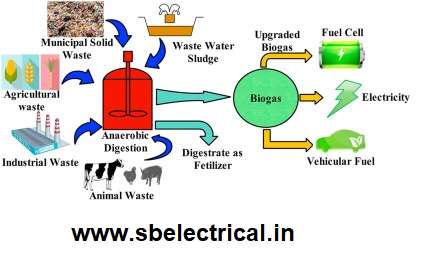
- April 13, 2023
- By sbelectricaladmin
- Electrical Services
The rising focus on conservation and sources of clean energy has caused a huge shift in the energy sector. Biogas is one of the most promising renewable energy sources since it is produced from organic waste using an anaerobic digestion process. If you take a closer look at the last few years, you will notice that the production of biogas has soared high. Moreover, being a big part of the global energy balance. Like any emerging industry, some challenges and opportunities must be overcome for biogas to realize all of its possibilities as a sustainable energy source.
Let us go further and take a look at the future trends, challenges, and opportunities of Biogas.
The 2023 Trends of Biogas
In 2023 and beyond, biogas is anticipated to play a bigger part in the world’s energy mix. The following are some of the major themes that will probably influence how biogas is used in the future:
1. Increased production of biogas
The production of biogas is anticipated to rise along with the need for environmentally friendly energy sources. The adoption of laws and policies that encourage the use of renewable energy sources will spur this expansion, as will the accessibility of organic waste streams that may be utilized as feedstock.
2. Improvements in technology
Technology advancements should increase the productivity and cost-effectiveness of biogas production. A larger variety of applications for high-quality biogas will be possible thanks to new technology like membrane-based bioreactors and gas-boosting systems.
3. Applications for biogas diversification
Although biogas has primarily been used for heating and generating electricity, there is growing interest in using it for other purposes, such as transportation fuel and chemical industry feedstock. The variety of uses for biogas will expand its market opportunities and raise its overall worth.
4. Integrating other green power resources into the mix
Biogas can be combined with other renewable energy sources, such as wind and solar, to create a more dependable and sustainable energy system. Biogas can be used to store additional energy and provide consumers with a more dependable source of power during times when wind and solar energy are not accessible.
5. A rise in investment
Expenditure in biogas generation is anticipated to go up as demand for clean energy sources rises. With the support of this investment, the development will be encouraged, and biogas production will become more productive and cost-effective.
6. Biogas: The Challenges
Although biogas has a bright future, there are still several issues that must be resolved before it can completely realize its potential as a sustainable energy source. The biogas sector is now confronting the following difficulties:
Availability and quality of feedstock
Organic waste streams, including food waste and agricultural waste, can be erratic and inconsistent in terms of accessibility and quality. As a result, it could be challenging to keep up an uninterrupted flow of feedstock for the generation of biogas.
Distribution and infrastructure
It may be difficult for biogas to become a widely used energy source because the infrastructure for its production and distribution has not yet been fully constructed. Wherever it is needed, biogas must be improved and transported, which can be expensive and necessitate major infrastructure expenditure.
Financial stability
The cost of feedstock, the effectiveness of the biogas production procedure, and the market value of the produced biogas are only a few of the variables that affect how economically viable biogas generation is. The production of biogas may not always be affordable compared to other forms of energy, which could restrict its use.
Environment-related issues
Although biogas is a renewable and sustainable energy source, its production can harm the environment, especially if it is not properly controlled. Methane, a potent greenhouse gas, may be released during the production of biogas, and using land for feedstock production may have further negative environmental effects.
Regulation obstacles
In many regions, laws and regulations that encourage the creation and use of biogas are still being developed. The possibility for biogas production or the capacity to market biogas as an industrial good may occasionally be constrained by regulatory obstacles.
7. Biogas: The Opportunities
Despite the difficulties the biogas industry faces, some chances could help it reach its full potential as a sustainable energy source. Here are a few chances for the biogas sector:
Cyclical economy
A crucial part of the circular economy, which treats waste as a resource, is biogas production. Producing biogas can help minimize waste and produce useful goods like organic fertilizer and biogas.
Electricity safety
Local production of biogas can increase energy security and lessen reliance on fossil fuels. This is crucial for areas that depend on imported energy or have limited access to conventional energy sources.
Creating jobs
Jobs in waste management, engineering, building, and maintenance might all be produced by the biogas industry. This may boost regional economies and promote sustainable growth.
Mitigation of climate change
By capturing and using methane, a strong greenhouse gas that would otherwise be released into the environment, biogas production can aid in lowering greenhouse gas emissions. This may help with the fight against climate change.
Research and invention
Significant potential for innovation and research is provided by the biogas sector. Technology advancements like gas upgrading technologies and procedure optimization may assist to raise the productivity and profitability of biogas production.
Conclusion
So here we are at the end of the Sbelectrical blog about biogas. What do you think about it? Do you think biogas is an essential option for conservation and sources of clean energy? Do let us know your thoughts in the comments below.